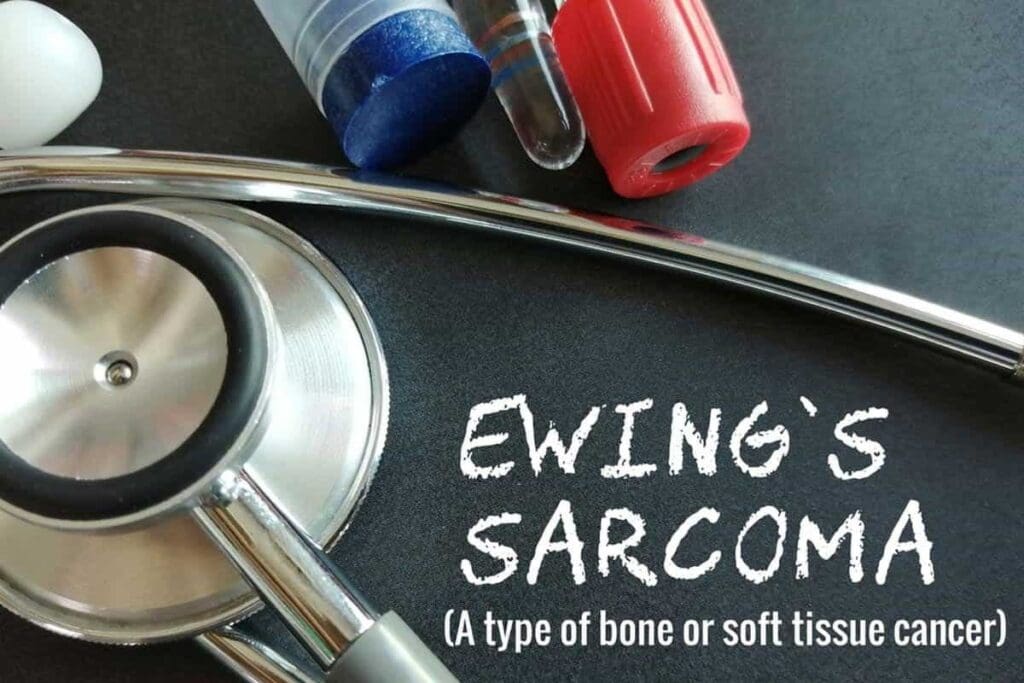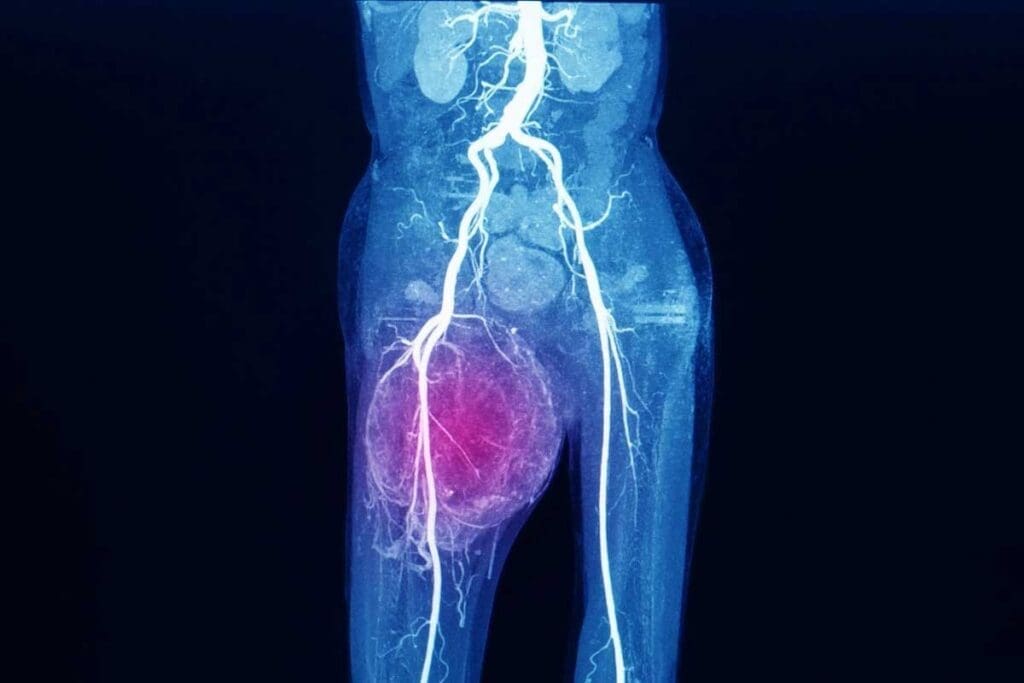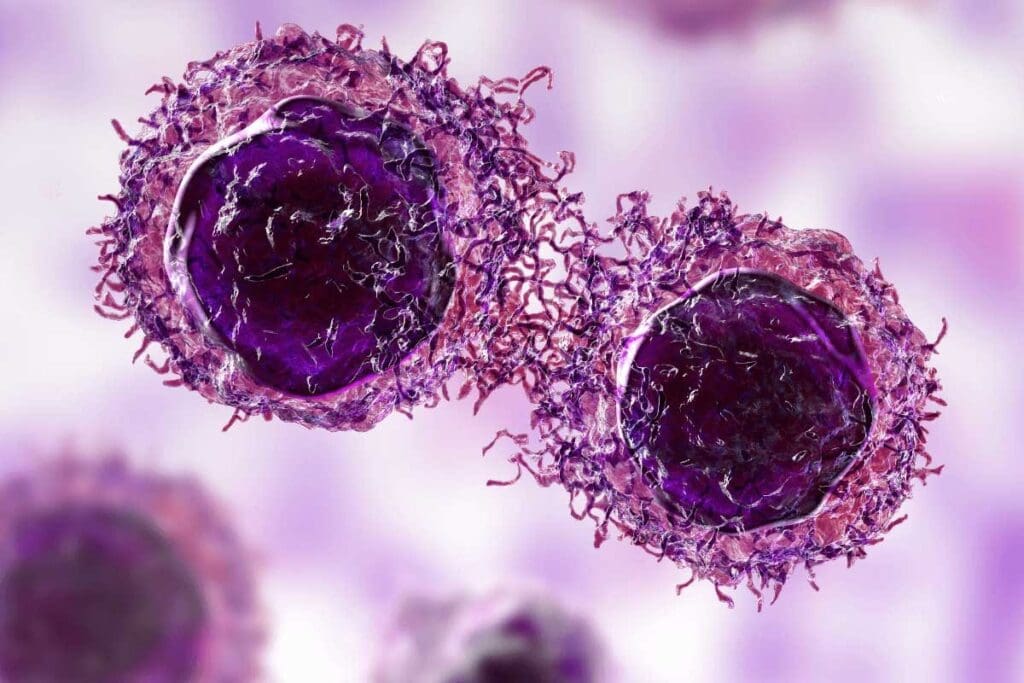Last Updated on November 20, 2025 by Ugurkan Demir

Ewing sarcoma is a rare type of cancer that affects the bones or soft tissues, most often in children and young adults. A Ewing sarcoma lump typically appears in areas like the legs, pelvis, arms, or chest.
These lumps can cause persistent bone pain, swelling, or tenderness, and they may feel warm to the touch. Recognizing the signs of a Ewing sarcoma lump early is crucial for timely diagnosis and effective treatment. Early detection can greatly improve a patient’s chances of recovery.

Ewing sarcoma is a group of cancers that happen in bones or soft tissues, mostly in young people. It’s aggressive and the second most common bone cancer in kids and young adults.
Ewing sarcoma is a malignant tumor that can be in any bone or soft tissue. It’s part of the Ewing family of tumors. These include Ewing sarcoma of bone, extraosseous Ewing sarcoma, and primitive neuroectodermal tumors (PNET). These tumors grow fast and often have genetic problems.
Key characteristics of Ewing sarcoma include:
Ewing sarcoma is rare, with about 1.7 children out of 1 million getting it. It’s more common in people of European ancestry. Most cases are diagnosed before age 20.
Ewing sarcoma lumps are soft and may feel warm. They can be soft and tender. Knowing what Ewing sarcoma lumps look like is key for early detection.
The high rate of Ewing sarcoma in young people highlights the need for awareness. Early detection is critical for better treatment outcomes.

It’s important to know where Ewing Sarcoma tumors usually show up. This helps doctors find and treat them early. These tumors often appear in bones and the soft tissues around them.
Ewing Sarcoma often starts in long bones like the femur (thigh bone), tibia, and fibula (lower leg bones). It also happens in the humerus (upper arm bone). Plus, it can be found in flat bones like the pelvic bone, scapula (shoulder blade), and ribs.
These bones are more likely to get Ewing Sarcoma. It’s because they have a lot of bone marrow. This is where the cancer is thought to start.
Ewing Sarcoma is mostly a bone cancer. But it can also show up in soft tissues around the bones. Soft tissue Ewing Sarcoma is less common but just as serious.
The soft tissues include muscles, tendons, and fat. Ewing Sarcoma in these areas can be very aggressive, just like in bones.
We don’t fully understand why Ewing Sarcoma likes certain spots. But it’s thought to be because of where primitive neuroectodermal cells are found. Scientists are working to learn more about what causes Ewing Sarcoma in these areas.
Knowing what Ewing sarcoma lumps look and feel like is key for quick medical help. This cancer usually hits bones or soft tissue around bones, showing up as a lump or swelling.
Texture and Consistency
Ewing sarcoma lumps are soft and might feel warm or tender. They can feel different, but are usually not hard or bony. Remember, their softness doesn’t mean they’re not serious.
One sign of Ewing sarcoma lumps is they might feel warm because of more blood flow. They can also cause pain, swelling, or inflammation, making them sensitive. Watching for changes in temperature or sensitivity is important for catching it early.
To sum up, Ewing sarcoma lumps are soft, might be warm, and sensitive to touch. Knowing these signs can help people get medical help fast if they notice any unusual lumps or changes.
It’s important to know the visual signs of Ewing sarcoma for early treatment. This disease can cause swelling or lumps. The skin over the tumor may also turn red or inflamed.
The look of an Ewing sarcoma lump can differ. The skin over the tumor might show:
In some cases, it might look like bruises or lipomas. But, it’s key to check any lasting lumps with a specialist.
Ewing sarcoma tumors can grow fast, causing noticeable changes. Important points include:
Watching a lump’s size and growth is vital. If it doesn’t go away or grows, seek medical help.
Early detection is key for effective treatment. Spotting the visual signs of Ewing sarcoma can lead to timely medical care.
It’s important to know the symptoms of Ewing sarcoma to get help quickly. Ewing sarcoma lumps can show different signs that help doctors find and treat them early.
Pain or tenderness at the tumor site is a key symptom. This pain can be constant and get worse. It might feel like a dull ache or a sharp pain, depending on the tumor’s size and where it is.
Swelling or inflammation around the tumor is common too. This swelling can be sore to the touch and make the affected area feel warm. Sometimes, the skin over the tumor may turn red or get inflamed.
Ewing sarcoma can also affect the whole body. Symptoms like fever, weight loss, and fatigue can happen. These symptoms show that the cancer is affecting the body’s health and metabolism.
The table below lists the common symptoms of Ewing sarcoma lumps:
| Symptom | Description |
| Pain and Tenderness | Persistent pain or tenderness at the tumor site |
| Swelling and Inflammation | Swelling or inflammation around the tumor, potentially with redness or warmth |
| Systemic Manifestations | Fever, weight loss, and fatigue due to the cancer’s impact on overall health |
Spotting these symptoms early can greatly improve treatment and outcomes for Ewing sarcoma. If you or someone you know is showing these signs, seeing a doctor right away is very important.
Ewing Sarcoma is rare but has clear differences from non-cancerous growths. It’s important for patients and doctors to correctly diagnose and tell Ewing Sarcoma apart from benign conditions.
Ewing Sarcoma grows quickly and needs a detailed diagnosis to be told apart from less serious conditions. Knowing these differences is key for planning the right treatment.
Lipomas and cysts are not cancerous and feel soft. They can be moved under the skin. Ewing Sarcoma, on the other hand, is hard and sticks to the bone or tissue around it.
Ewing Sarcoma grows fast, unlike lipomas and cysts which grow slowly or stay the same size.
| Characteristics | Ewing Sarcoma | Lipomas/Cysts |
| Texture | Hard, fixed | Soft, movable |
| Growth Rate | Rapid | Slow or static |
| Pain | Often painful | Usually painless |
Bruises and infections can look like Ewing Sarcoma, causing swelling or pain. But bruises heal in a couple of weeks, and infections get better with antibiotics.
Ewing Sarcoma needs special cancer treatment and doesn’t get better on its own. It also causes fever, weight loss, and tiredness, unlike simple bruises or infections.
“Early diagnosis is critical in managing Ewing Sarcoma effectively. Distinguishing it from benign conditions is the first step towards appropriate treatment.”
— Expert Oncologist
In summary, Ewing Sarcoma looks similar to benign conditions at first glance. But its fast growth and other symptoms make it different. Accurate diagnosis is key for good treatment.
When Ewing sarcoma is suspected, a detailed diagnostic process starts. It includes a thorough physical check-up and advanced imaging. This journey is key to finding the right treatment and improving patient care.
The first step is a detailed physical check to look at the lump’s size, tenderness, and how it moves. Places like Liv Hospital focus on early detection and quality care. They also take a detailed medical history to look for signs of Ewing sarcoma.
Key aspects of the initial assessment include:
Imaging is key in diagnosing Ewing sarcoma. X-rays, MRI, and CT scans help see the tumor and how big it is. These tools help doctors:
Experts say, “Imaging is vital for staging Ewing sarcoma and planning treatment.” It not only helps in diagnosing but also in tracking how well the treatment is working.
A biopsy is needed to confirm Ewing sarcoma. It involves taking a piece of the tumor for a microscope check. This check looks for specific genetic signs of the disease.
The biopsy process involves:
Diagnosing Ewing sarcoma is complex and needs a team effort. Doctors, radiologists, and pathologists work together. Places like Liv Hospital are key in managing the disease well.
Ewing sarcoma needs quick medical check-ups. Knowing the warning signs helps get help fast. Watch for any unusual changes in your body and see a doctor if you notice them.
Some symptoms point to Ewing sarcoma. It’s important to know these signs. Here are the main ones:
These signs might mean you have Ewing sarcoma. If they keep happening or get worse, see a doctor right away.
| Red Flag | Description | Action |
| Persistent Bone Pain | Pain that doesn’t improve with rest and may worsen at night | Consult a healthcare provider |
| Swelling or Lump | A growing mass or swelling in the affected area | Seek immediate medical attention |
Finding Ewing sarcoma early is key to better outcomes. The hospital works hard to improve care. This ensures patients get the best help from start to finish.
Acting fast can greatly improve Ewing sarcoma treatment results. Knowing the warning signs and getting help quickly is very important.
The table above shows the main Ewing sarcoma warning signs and what to do. It’s vital to know these signs and see a doctor if you notice them.
Effective treatment of Ewing Sarcoma needs a team of specialists working together. This cancer is complex, so a full approach is needed.
A team of experts is key in fighting Ewing Sarcoma. This team includes oncologists, surgeons, and radiologists. They create a treatment plan that fits each patient.
This team makes sure every part of the disease is covered. They help from the start to the end of treatment and beyond.
For Ewing Sarcoma, treatments often mix chemotherapy, surgery, and radiation. The choice depends on the tumor’s size, location, and the patient’s health.
| Treatment Modality | Description | Application |
| Chemotherapy | Use of drugs to kill cancer cells | Systemic treatment to address possible metastasis |
| Surgery | Removal of the tumor and surrounding tissue | Local control, for tumors not helped by other treatments |
| Radiation Therapy | Use of high-energy rays to kill cancer cells | Local control, for tumors not fully removed by surgery |
New treatments and clinical trials offer hope for Ewing Sarcoma patients. These include targeted and immunotherapies. They are being tested to see if they can improve treatment results.
Joining clinical trials can give patients access to new treatments. These are treatments not yet widely used.
The outlook for Ewing Sarcoma patients depends on many factors. These include how well the treatment works and the tumor’s characteristics. Knowing these details is key for both patients and doctors to tackle this condition’s challenges.
Several important factors affect Ewing Sarcoma survival rates. These include the disease’s spread at diagnosis, the tumor’s location, and treatment response. Early detection and aggressive treatment are critical in improving survival chances.
Patients with localized Ewing Sarcoma usually have a better outlook than those with spread disease. The tumor’s location also matters, with some spots being harder to treat than others.
Survivors of Ewing Sarcoma need ongoing care to watch for treatment side effects and possible recurrence. Regular check-ups and screenings are vital for early detection of any complications.
Follow-up care involves a team of healthcare experts, including oncologists and radiologists. The type and frequency of visits depend on the patient’s treatment history and health.
Understanding Ewing Sarcoma’s prognosis and long-term aspects helps patients and families. It allows them to better manage the disease and make informed care decisions.
It’s important to know what a Ewing sarcoma lump looks like for early detection. These lumps can appear in different parts of the body. They often have specific signs and symptoms.
Knowing what a sarcoma lump looks like and its symptoms helps get medical help fast. This is key for better treatment results in Ewing sarcoma patients.
Early detection and treatment are essential for managing Ewing sarcoma. Being aware of the signs and symptoms helps get medical help quickly. This can lead to better treatment outcomes.
A Ewing sarcoma lump may show signs like pain, swelling, and limited mobility. These can greatly affect a person’s quality of life if not treated.
Quick diagnosis and treatment of Ewing sarcoma are critical. They help improve patient outcomes and lower the risk of complications.
A Ewing sarcoma lump can look like a swollen area or a mass. It might change color and feel different on the surface. It can also be tender and painful.
Ewing sarcoma lumps are often firm or hard. Their texture can help tell them apart from other conditions.
These tumors usually happen in the pelvis, chest wall, and limbs. They can also appear in soft tissues.
Ewing sarcoma grows faster and can cause pain and other symptoms. Benign conditions like lipomas or cysts grow slowly and don’t hurt.
Symptoms include pain, swelling, and inflammation. You might also feel feverish and tired.
First, you’ll get checked by a doctor. Then, imaging like X-rays or MRI scans are used. A biopsy confirms if it’s Ewing sarcoma.
See a doctor if you notice a new or changing lump. This is important if it’s painful, swollen, or has other symptoms.
Treatment involves a team of doctors. It might include chemotherapy, surgery, or radiation. This depends on the tumor’s stage and location.
The outlook depends on the tumor’s stage, location, and how well it responds to treatment. Early action is key to better chances.
Yes, new treatments and trials are being explored. This gives hope for better outcomes for patients.
Subscribe to our e-newsletter to stay informed about the latest innovations in the world of health and exclusive offers!